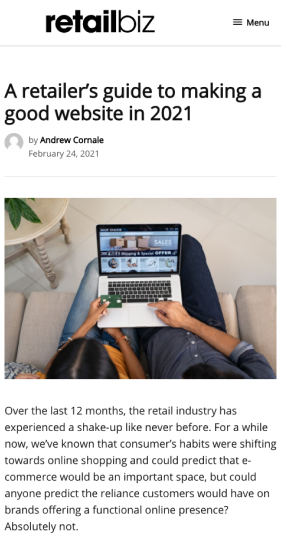Over the last 12 months, the retail industry has experienced a shake-up like never before. For a while now, we’ve known that consumer’s habits were shifting towards online shopping and could predict that e-commerce would be an important space, but could anyone predict the reliance customers would have on brands offering a functional online presence? Absolutely not.
In November last year, Australia Post reported that online shopping purchase growth for October was tracking at 72.9 per cent year-on-year (YOY). That’s enormous! Then in December, it reported that a whopping 5.5 million households had shopped online in November alone. 5.5 million in just one month. The January report which showcases the end of year statistics was equally as mind-blowing, revealing that a total of over 8.9million households shopped online in 2020, averaging an additional million households per month.
This tells us a few things.
- Shoppers are becoming more digitally savvy and online shopping is the method of choice for many Australian households.
- E-commerce is a powerful space for retailers to be present in and it’s no longer ‘nice to have’, it’s expected.
- If you’re a retailer with an e-commerce store but you’re not converting customers, it’s time to ask why.
The truth is in the numbers; customers are making purchases online and they’re doing it frequently. So how can retailers ensure they’re providing the best website for their customers to ensure they’re the brand of choice when it comes time to make their next purchase?
- Know your overarching strategy and stick to it
When designing a website, it’s important to do so with an overarching strategy in mind. Ask yourself, what is the purpose of this website? What are we encouraging users to do? What direction are we pointing customers in?
Defining a strategy early on is essential to creating a good, logical website that is structured to guide users towards conversion. When websites are developed with strategy in mind, clicking through it should be like reading a good novel. The first page reels you in and gives you just enough information that you’re intrigued to turn the page. For every page after that, imagine your services and products are like characters and each click is an opportunity to get to know them better. The website should guide them smoothly from page to page, telling the story of your brand as it goes.
Website development can be overwhelming and the original objective can get lost easily. Having an overarching strategy to guide the website and content structure ensures retailers are always mapping back to their original goals.
- Make a logical user experience your first priority
Web design isn’t as superficial as it seems. Yes, it needs to be pretty but that’s not its only function. Design takes into account strategy, user flows and buyer personas to make a flawless and logical user experience.
Customers have always been difficult but the online customer is something else. They’re busy, distracted, impatient and have several other back-ups if you can’t give them what they want within seconds. For this reason, user experience needs to be your number one priority when developing a website. It needs to be simple, clear, pre-empt their wants and display information in digestible ways. Prioritising user experience is the easiest way to guide users towards conversion.
- Optimise your website
You could have the prettiest website with the most logical functionality but if it takes longer than a few seconds to load then you’re in trouble. As mentioned before, customers are impatient, even more so when they’re shopping online. Think to yourself, when have you ever waited longer than a few seconds for a site to load before closing it and switching to another? Probably never.
Site speed is essential to keeping customers happy and it’s an entirely achievable task. For retailers who have multiple product pages and are reliant on imagery to showcase their product (like fashion or make up retailers), it’s simply not an option to remove pictures in order to increase site speed. The pictures are what sells the products so it’s essential to find ways to keep them in there, while increasing the efficiency of the site load time. This can be done by compressing the file size using tools like photoshop or kraken.io. This allows brands to minimise the file size which will increase site speed, while retaining the original quality of the photo.
Consumer habits are shifting to online and retailers need to keep pace, starting with their website. Developing an overarching strategy, prioritising user experience and optimising your website is key to ensuring that your brand is the one consumers go to when looking to make their next purchase.
Andrew Cornale is co-founder and digital experience director at UnDigital



